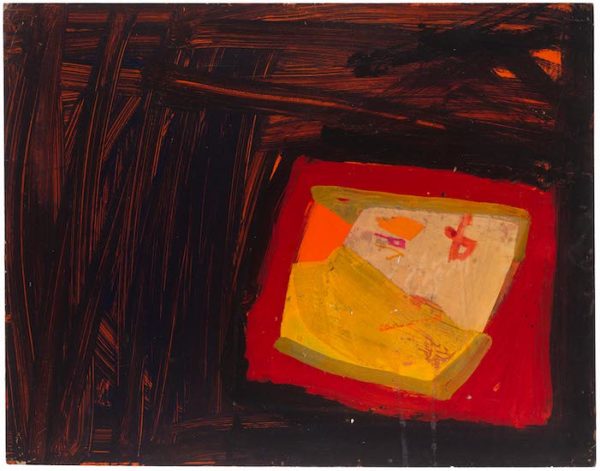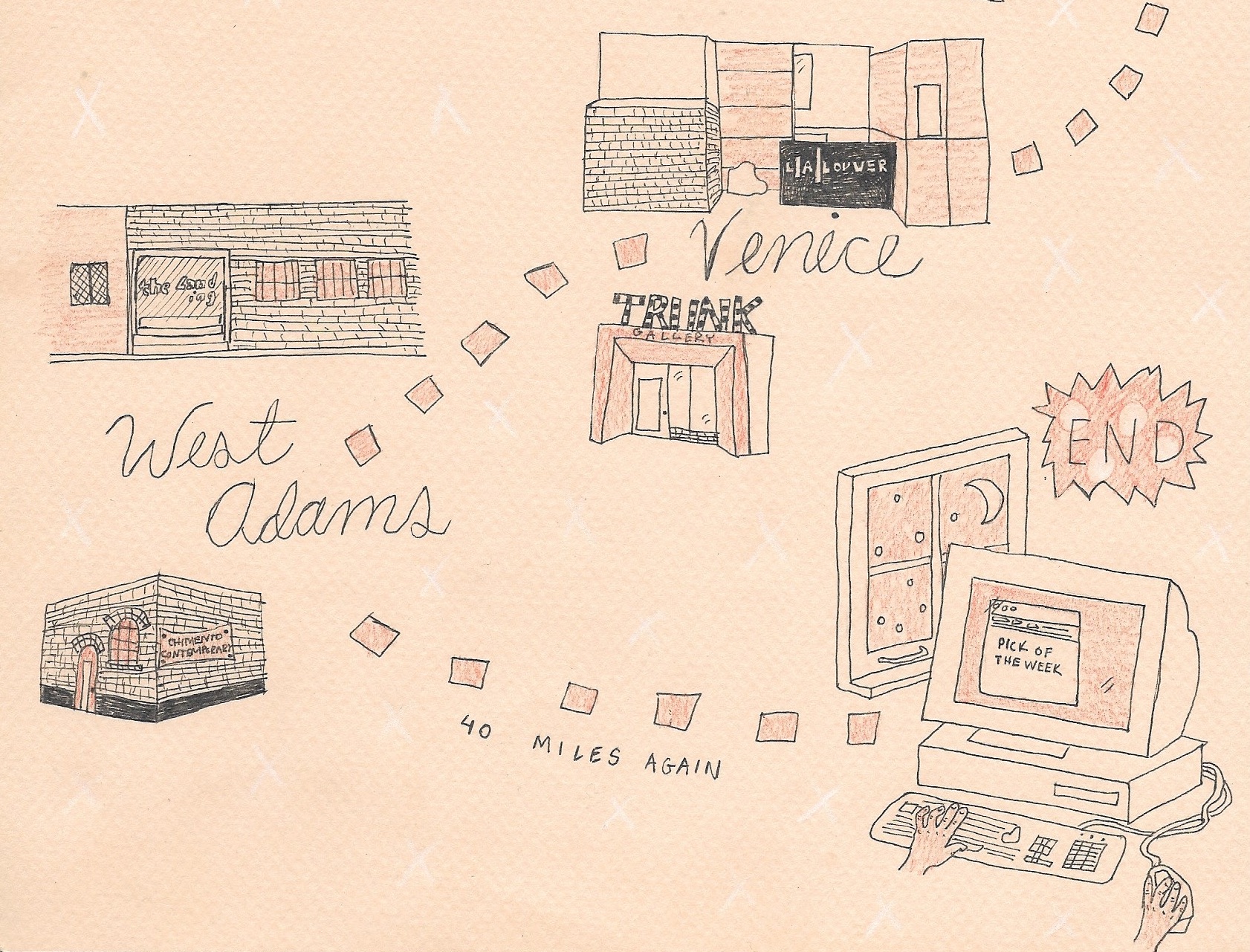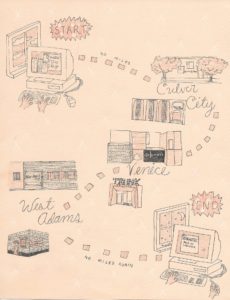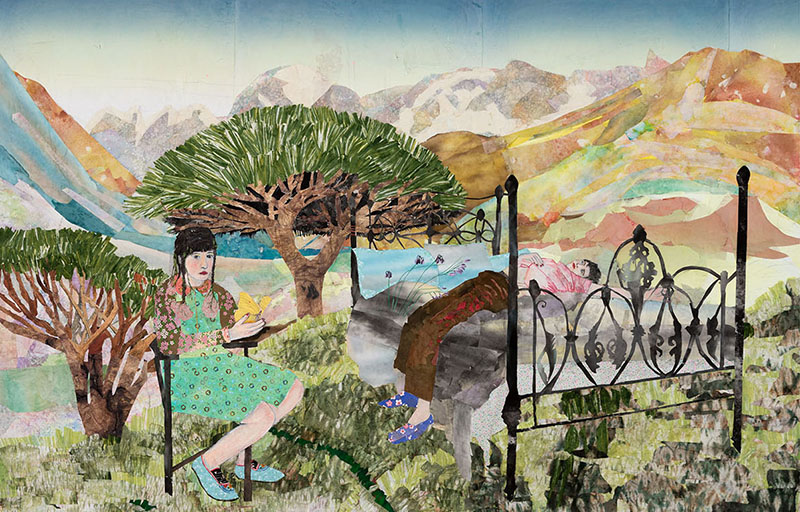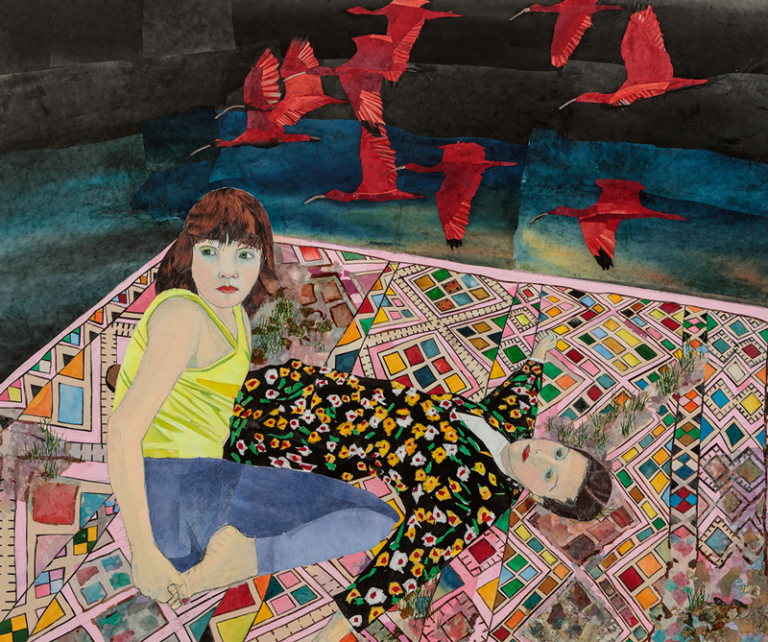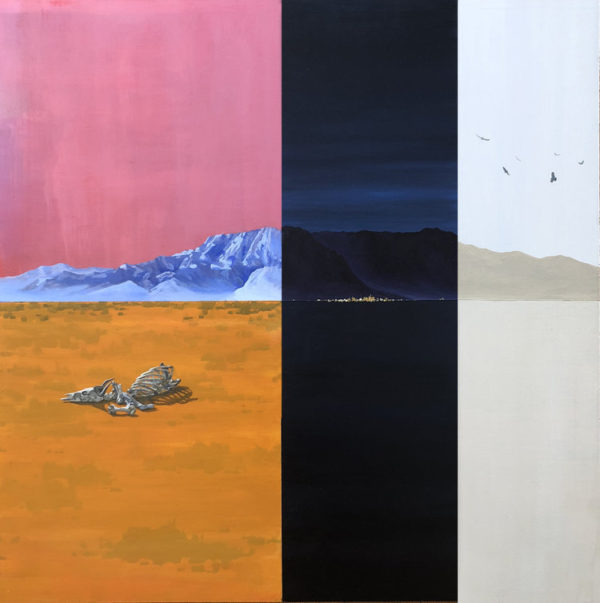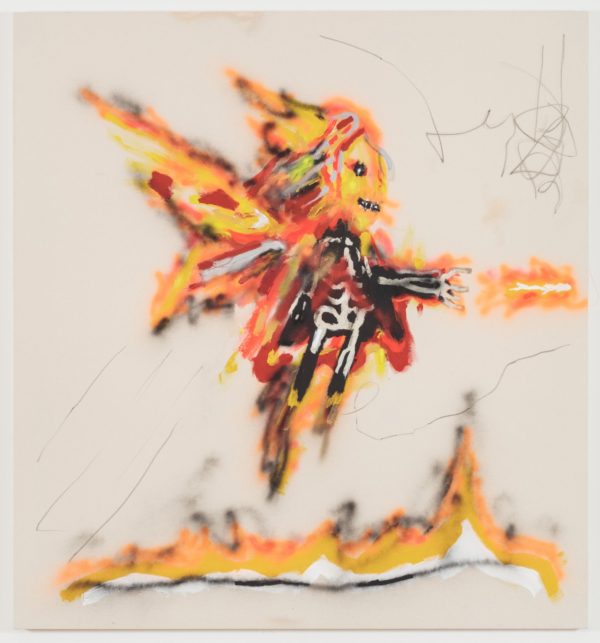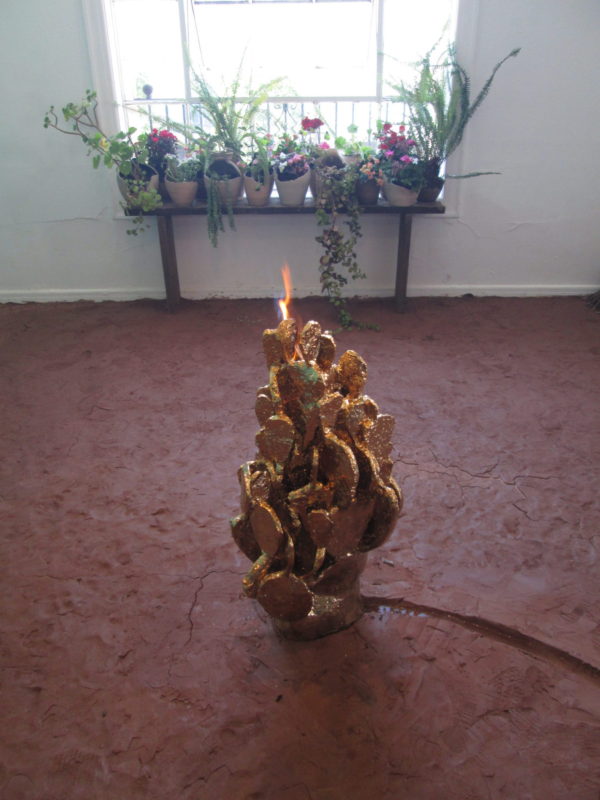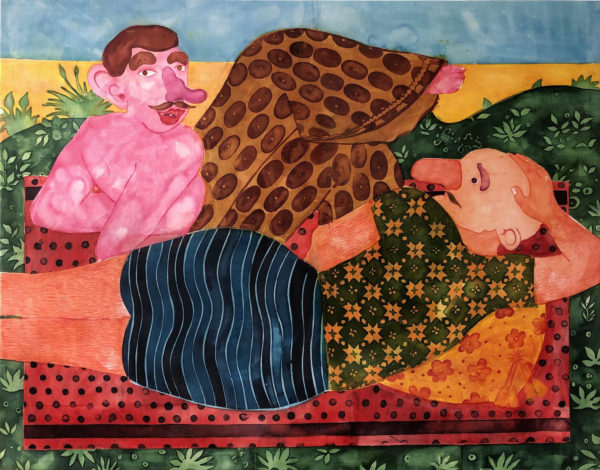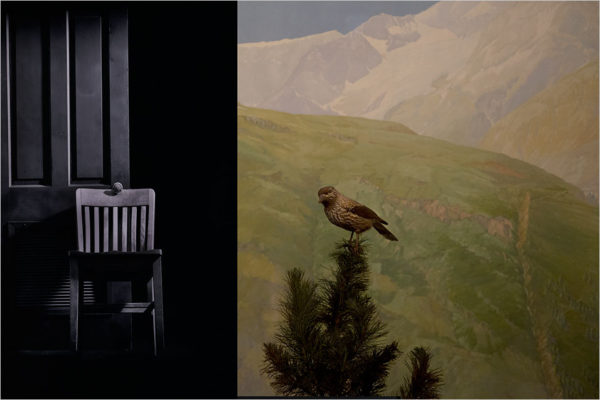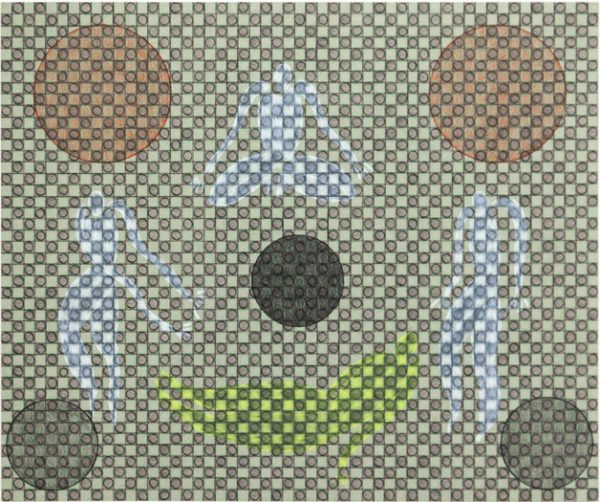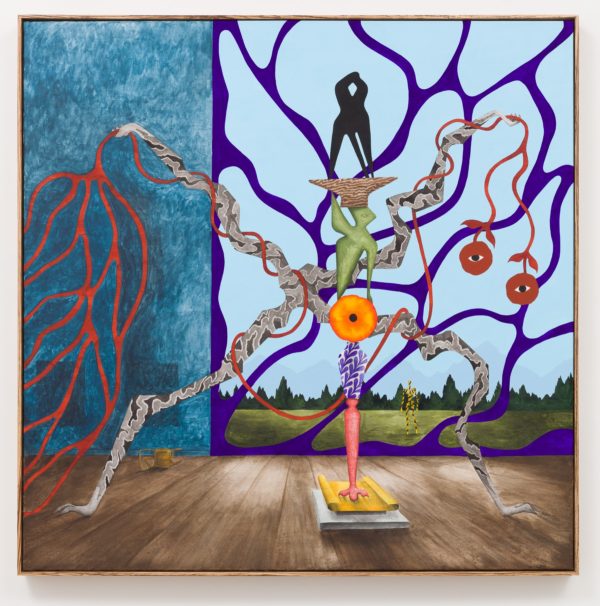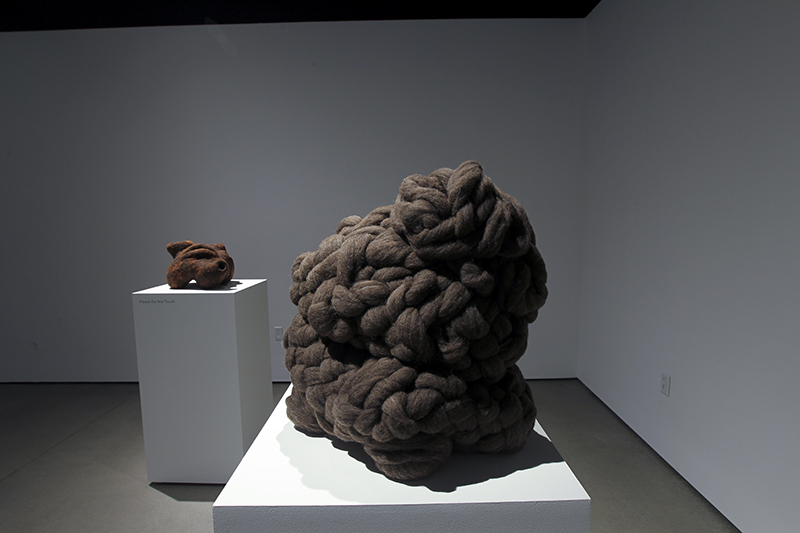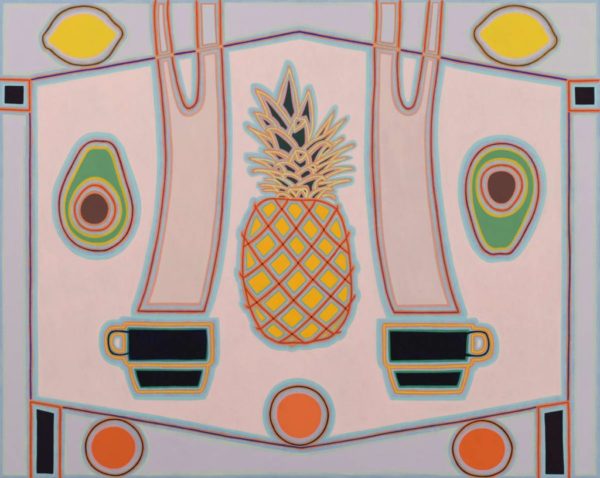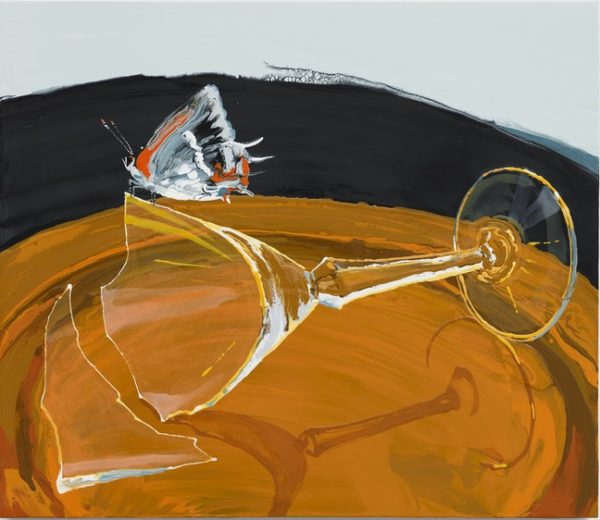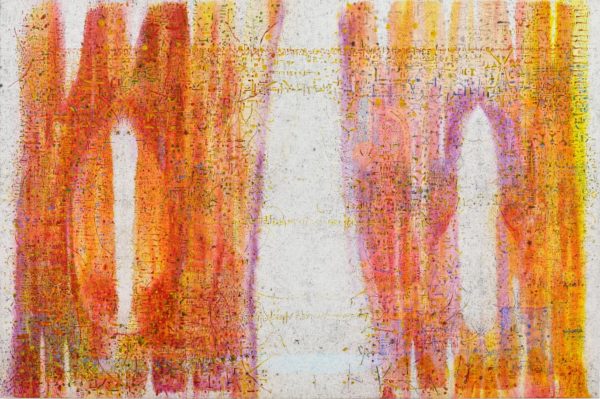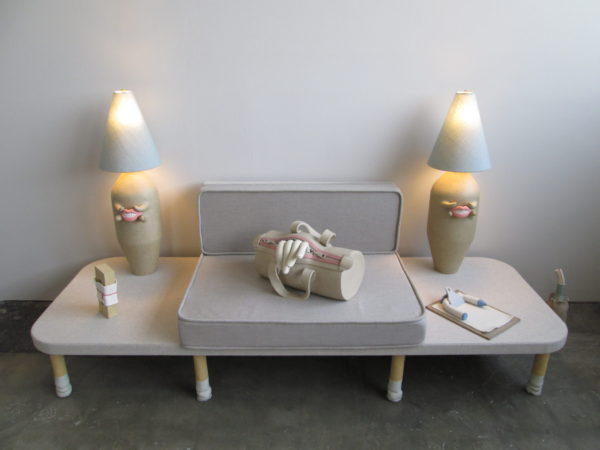Your cart is currently empty!
Byline: Annabel Osberg
-
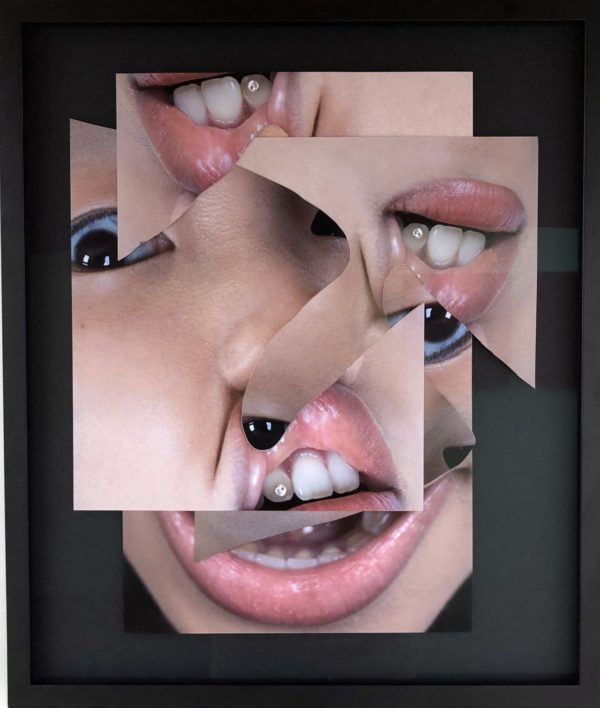
“Don’t Just Do Something, Sit There”
Dark humor pervades provocative works by Jesse Draxler, Jordan Weber and Mark Mulroney in “Don’t Just Do Something, Sit There” at NO Gallery. These artists hail from different regions yet overlap in their hard-bitten manners of exploring mortality and contemporary unpleasantries. Ironically denoted “Happiness,” Draxler’s series of photo-collages appears as a rogues’ gallery of medically unsound facial composites. Sporting bizarre grimaces liable to induce nightmares even in a dentist, the LA artist’s Frankensteinian monstrosities, such as the subject of Happiness 1 (pictured above, all works 2019), bring to mind Internet trolls and fraudulent identities, encapsulating modern life’s existential angst. Grittier than Draxler’s overt grotesquerie, Jordan Weber’s work is equally disquieting in its evocations of trauma. In pieces such as Shined On, the Des Moines, Iowa-based sculptor adroitly combines signifiers of anguish, such as bullet-ridden armored truck doors, with tokens of aspiration typically associated with low-income black American communities. Nearby, North Haven, Connecticut-based Mark Mulroney’s colorful paintings satirize society’s obsession with semblance at the expense of substance. In American Likes, a lame, bleeding horse carries a standard-bearing rider. The equine’s skin is ripped away and its intestines have fallen into a pail below; but a casual observer is so occupied by snapping a close-up of its fundament extruding excrement that he hardly notices its wounds—or even his own.
NO Gallery
1115 S. La Brea Ave.
Los Angeles, CA 90019
Show runs through Oct. 19 -

Jay DeFeo
At Marc Selwyn a year ago, “Jay DeFeo: The Texture of Color” included small paintings on paper from 1982-86. Those works imparted an inventive sense of discovery while also showcasing the artist’s formidable expressive talent. The same is true for her current show, “The Language of Gesture,” which harks back three prior decades to DeFeo’s incipient career as she produced her first significant body of work upon receiving her MA in art in 1951. This selection of 18 untitled paintings on paper spans 1951-54 in Paris, Florence, New York and Berkeley; the earliest were completed during an extended period of postgraduate travel, and the latest were done after returning to her Bay Area studio. A variety of marks, shapes, materials and palette evince the formative nature of this prolific era in DeFeo’s career, presaging the interests that she would continue to explore with increasing refinement. Some pieces appear as studies offering insight into her thought processes, while others stand alone as finished paintings. Lost in these evocative abstractions, one may find architectural forms, birds, mask-like faces, a postage stamp, a cow’s head, a volcano spewing smoke, a rain cloud and other tokens of the concrete world.
Marc Selwyn Fine Art
9953 South Santa Monica Blvd.
Beverly Hills, CA 90212
Show runs through Sep. 14 -

Quality Is Subjective
As Artillery’s “Pick of the Week” columnist, I review a notable LA show every Wednesday. Each Pick is a one-paragraph critical snapshot of a show that I think one should see. Writing is only half the job; scouting candidates for the column is my most intricate duty.
I’m always looking for unrecognized artists and venues that haven’t received much press. Blue-chip and museum shows being widely celebrated, I want the column to alert readers to exceptional shows that are lesser known. Prominent venues’ offerings are Picks only if they impress me over and above the typical high-profile shows.
Quality is subjective; and Pick of the Week is just one critic’s perspective on what art is noteworthy. My main criterion is that I only cover shows I would recommend. Simply put, each week’s Pick is what I have most enjoyed seeing; it’s either a show that appeals to me, evokes a specific mood, provokes intriguing thought, or is so memorably unique as to keep me thinking about it long afterward. Ideally, my review will outline the artwork’s significance, encapsulate the enthusiasm I felt for the show, and serve as an interpretive guide should readers choose to attend the exhibition.
Much effort is devoted to keeping track of what’s being shown, and combing through my email from galleries, artists and press agents often provides me with valuable leads. On average, I spend two to three days a month visiting galleries. Since I live about 40 miles from LA, every trip must count.
Scheduling can be complicated, as timing plays a major role in shows’ Pick of the Week eligibility. Each subject must be on view for at least one week after a Pick is published. My objective is for readers to visit the show, so ease of access is also a consideration; galleries that are only open by appointment, or one day a week, are rarely suitable.
The day before my gallery round, I consult various public listings to get a comprehensive picture of new openings, relying primarily on three websites: Artillery’s “Calendar” section, Curate LA and What’s On Los Angeles. For each exhibition that catches my eye, images are vetted on the gallery’s website. I’ve learned to trust my instincts, but not be overly confident in them. Many lackluster shows appear superior in reproduction; and some shows that look uninspiring online prove excellent in person.

Illustration by Frances Cocksedge. My itinerary is organized around the most promising candidates. Taking traffic and relative distances into consideration, I seek to minimize drive time by devising a practicable tour of galleries in a line, clusters or areas connected by a freeway or major highway. For instance, Venice and Glendale are seldom reasonable in one day; but Venice, Santa Monica, Culver City and West Adams could easily be a workable grouping. Once a course is decided, each stop is plotted on an online route planner to create a printable custom map of their locations, which aids in further refining and prioritizing my circuit. Traveling miles out of the way for one gallery is infeasible unless its show greatly piques my interest. With the route map as model, addresses are plugged into a GPS.
After vetting shows online and maximizing my itinerary, I can visit 10 galleries and five of them might yield viable Picks. Usually, I’m lucky to find three shows for the column. To allow for uncertainty, my Pick of the Week schedule is planned at least two to three weeks ahead.
Subsequent to the background research and reconnaissance, the actual writing seems comparatively simple. Two years at Pick of the Week has made the format so familiar that I can readily identify salient themes and concentrate on composing the review with little anxiety for word count. Yet there are no shortcuts to writing well, which invariably requires time, effort and perfecting. Depending on my familiarity with the subject, a Pick takes me anywhere from a few hours to a day to complete.
The final step is selecting an image to appear with my review on Artillery’s homepage. This is in the back of my mind while writing, for the accompanying image usually portrays a work cited in the text. As the only visual indication of the show, this picture is crucial; so I often test several possibilities and select the most exemplary or eye-catching candidate. Other suitable images from the show are sent to Artillery’s publisher for use in social media posts and our Thursday newsletter.
Once the Pick is scheduled to post on Wednesday afternoon, this week’s work is done—and I’m onto the next discovery. Perpetuating this cycle is effortful; but the thrill of encountering superb art and transmitting that experience to my readers seems a worthy reward.
-

María Berrío
Born in Bogotá, Colombia in 1982, María Berrío moved to the U.S. at the age of 18. Childhood recollections of exploring her family’s rural mountainside farm figure prominently in her large-scale collages depicting female figures inside vacant interiors and illusory landscapes. Appearing as symbolic daydreams of her motherland, the New York-based artist’s mythical scenes combine autobiography with ambiguous folkloric references from South America and beyond.
With an emphasis on pattern recalling that of Gustav Klimt, Berrío’s pictures are suffused with idealism tempered by mystery. Beautifully attired women with sober, dreamy miens inhabit otherworldly spaces where the patterns of their floral clothing alternately coincide and contrast with surrounding foliage, terrain and decor. Diverse motifs, including rituals of indigenous peoples of Colombia, betoken the multiculturalism of South America and the U.S.; yet these appear so general that anyone could relate to them.

María Berrío.The Dream of Flight, 2019, courtesy Kohn Gallery Much of Berrío’s work lends visionary buoyancy to the sense of dislocation often faced by immigrants. The picture after which her Kohn Gallery exhibition was titled, A Cloud’s Roots (2018), portrays two girls leaning against the trunk of a fanciful tree modeled after an actual species, the dragon blood tree endemic to Socotra, an island off the coast of Yemen. Berrío posits that species, finely adapted for survival in a hardscrabble arid habitat, as an allegory of the figures’ potential for resiliently putting down roots in whatever harsh conditions they might encounter. The girls pose determinedly; but behind the tree is nothing but darkening firmament that seems to indicate an uncertain future.
Pieced together of painted paper and some printed material on canvas, Berrío’s works are technically collages; yet her imaginative compositions are unified so harmoniously that each canvas has the presence of a painting. Impact is added by the unexpected textures of her piebald materials: walls are suggested by wrinkled paper glued to canvas; skies are evoked by broad passages of watercolor-stained Japanese paper. A remarkable sense of depth unfolds as you approach each collage and stark expanses give way to minute areas of detail, such as a tiny framed portrait atop the nightstand in Flower Mirror Water Moon (2019). The patchwork composition of these scenes seems an apt metaphor for a transplant’s reconceived memories and restructured notions of belonging.
In fact, Berrío’s portrayed spaces are so exquisitely evocative that occasionally her relatively stiff figures fall flat in comparison. More development of her animal and human protagonists would have better served The Paradise of Others (2019), where an expressionless group of children and ibises detracts from the fascination of a strange house on stilts, denuded forest and pot of livid roses.
Anemochory (2019), whose title refers to seed dispersal by wind, sparkles with quiet emotion. Dragon blood trees reappear in the background of this absorbing scene portraying two figures improbably marooned in an outdoor setting. One disheveled girl is flopped width-wise on a four-poster bed as though impatiently exhausted by the interminable wait for something interesting to happen. On a nearby chair, her more neatly garbed companion sits gingerly holding a large butterfly, her sidelong gaze betraying wistfulness. The children’s nervous sense of anticipation is palpable: Like dandelion seeds, where will they go?
-

Holly Elander
Holly Elander‘s quiet Los Angeles cityscapes exude a strong presence. Desolation brings out the personalities of inanimate features that would otherwise be easily overlooked in neglected byways. This exhibition includes 21 acrylic-on-panel paintings from two divergent but equally open-ended series. “Solitary Shadows” takes you on rambling nighttime excursions through deserted alleys where apartment buildings, driveways and garages are spied through a Hitchcockian lens conferring eerie gravity upon glimpses of illuminated windows and shadows of vegetation. Mysterious chiaroscuro lures you into voyeuristic speculation about the unseen inhabitants of paintings such as Pico (all works 2019). Strangeness is pushed further in Elander’s other series, “Fine Line,” where scenes of land, sea and still lifes are divided into surreal stripes or color blocks in configurations recalling geometric abstraction. These starkly delineated alterations in hue give the impression of looking through colored gels, suggesting the artifice of different human views of nature. Time is flattened in paintings such as Circle, pictured above, where a horned creature’s skeleton lying on an orange-tinged desert floor in broad daylight seems eons away from an urban settlement in the dusky distance. Sidestepping bustle, Elander’s work invites a more reflective outlook towards our metropolitan environs.
Launch LA
170 S. La Brea Ave.
Los Angeles, CA 90036
Show runs through Aug. 24 -

Jasmine Little; Robert Nava
Jasmine Little‘s ceramics and Robert Nava‘s paintings both incorporate breezily limned imagery of fantastic creatures and people. At a distance, the large stoneware vessels in Little’s show, “Retrograde,” appear deceptively old-fashioned; their brown-and-white palette and vaselike forms recall antiques such as Greek amphoras and Staffordshire pottery. Art historical references abound on these vessels’ carven surfaces bearing pageants of whimsical imagery: cameo appearances are made by the “Venus of Willendorf,” beasts from Lascaux cave paintings, and a dancing trio of nymphs from Botticelli’s “Allegory of the Spring.” Yet Little’s exuberant painterly style is decidedly contemporary, transmitting the notion that art history is made to be reimagined. With similarly whimsical flair, Nava interprets enduring folkloric characters such as dragons, ghosts, witches and robots. At a glance, his frenzied smudges and scrawly lines convey a spontaneous immediacy akin to that of children’s drawings; yet his paintings’ studied sophistication reveals itself upon closer observation. Most painters will relate to the notion of a canvas as a battleground; and Nava’s show’s title, “Vs,” is meant as a metaphor for the dilemmas and struggles he faces in endeavoring to paint interesting pictures. And it seems that he generally succeeds, for characters such as the skeletal witch in Fire and Bone Angel (2019, pictured above) sizzle with painterly energy, seeming to come alive despite their indistinct figuration.
Night Gallery
2276 E. 16th Street
Los Angeles, CA 90021
Shows run through Aug. 17 -

Armando G. Cortés; Hande Sever
Wilmington-based artist Armando G. Cortés has incorporated realities and legends from his birthplace, Urequío, a small farming town in Michoacán, Mexico, into a captivating installation titled “Reverberante.” Natural springs run through some Urequío adobe homes’ clay floors; residents must carve channels to divert the water outdoors. In allusion to this phenomenon, the gallery floor is covered in a thick layer of reddish clay bisected by a meandering watercourse appearing to have sprung from the earth despite the gallery’s second-floor location. As if by magic, the water constantly flows and disappears into Llama en el llano (2019), a gilded stoneware sculpture of a nopal that doubles as a fireplace. During the opening reception, the artist diligently stoked a fire of aromatic wood inside the nopal, filling the air with smoke whose scent evoked some other time and place. Two colored-pencil portraits fancifully portray Cortés’ young cousins inside their grandmother’s garden, surrounded by animals and plants symbolic of portent and resilience; out of concern for political uncertainties, the artist has been teaching gardening and adobe-making to these boys who have never visited Urequío but could one day be forced to move there. On a shelf adjoining the window sits an assortment of botanical specimens whose vitality contravenes their broken containers. Nearby, Hande Sever also employs plants as a symbol of hope amid distress in “When the Geraniums Bloom,” a simple yet touching installation relating to her mother’s incarceration amid the 1980 Turkish military junta.
Visitor Welcome Center
3006 W. 7th St., Suite 200A
Los Angeles, CA 90005
Shows run through Aug. 24 -

Orkideh Torabi
Orkideh Torabi’s painted burlesques of men offer sardonic commentary on patriarchal oppression of women in Iran and beyond. The Tehran-born, Chicago-based artist’s 2017 LA show featured mostly frontal portraits of caricatural men whose stark, formal poses against Persian patterns heightened their appearances of self-satisfied foolishness. Her new paintings build on the previous with added humor and intricacy, depicting full-length male figures in pairs or groups engaging in activities from which women are excluded. The title of her show, “Give them all they want,” suggests the liberty granted uniquely to men in Iran, where laws and customs restrict or prohibit women from partaking in many pastimes. Thus it’s always boys’ day out for Torabi’s protagonists, who frolic at leisure with not a care in the world, not a woman in sight. Reversing their ascendancy, Torabi bestows her characters with ruddy doll cheeks, aggrandized proboscises and terrible teeth that amplify their hilarious appearance as they revert to juvenility in playing with rubber ducks, gossiping like teenagers, and running around barely clothed. The absence of women is filled by the gents’ own femininity; for instance, the reclining pilgarlic in Wanna Join? (2019, pictured above) nonchalantly flaunts his girlish posterior remarkably well-suited to his striped skintight miniskirt. Highlighting the absurdity of entitlement based on one’s sex, Torabi’s comical paintings deliver a serious message: perhaps these delicate men’s urge to dominate women stems partly from their own insecurity. Fewer rights for women means fewer competitors.
Richard Heller Gallery
2525 Michigan Ave. #B-5A
Santa Monica, CA 90404
Show runs through Aug. 10 -

Eileen Cowin; “Group Show: Drawings and Other Works on Paper”
Eileen Cowin‘s solo exhibition at As Is comprises eight photographic works chosen from two series, “Mad Love,” and “Kafka’s Diary.” Each of Cowin’s pictures cleverly pairs two disparate photos whose strange vertical abutment evokes emotion and suggests open-ended narratives. Nature and artifice, contemplation and despair, new and old, technology and tradition are pitted against one another in these stark juxtapositions simmering with latent significance; the longer you look, the more potential stories you will find. In Mad Love: Only a Vague Hope (2015, pictured above), a chipper songbird perches next to a somber scene of a door barred by a chair; at first glance, the avian appears sprightly and free, but its stiff taxidermy pose and painted background indicate that it is likely part of a diorama. From Kafka’s Diary (2017) presents a captive school of fish swimming in lucid water beside a woman holding a cloth to her face amid smoky environs. These scenarios seem to ask, “Who is more confined, the people or the animals?” In the gallery beyond Cowin’s show is a thoughtfully curated exhibition of works on paper by eight artists. Most memorably, Ron Griffin confers an eerie grace upon a most improbable subject—toilet seat covers, which he has folded like origami and painstakingly painted in white enamel against rich black paper. Jennifer Celio‘s pencil drawings imagine a not-so-fictional world where forests envelop cell phone towers and real trees are caged beside signs reading “Do Not Touch.” Both of these shows offer much to contemplate.
As Is
1133 Venice Blvd.
Los Angeles, CA 90015
Shows run through Jul. 27 -

Hanna Hur
Hanna Hur believes in art’s power to generate supernatural experiences. By repetitively drawing geometric forms and fashioning chain mail sculptures link by link, she places herself in meditative states of mind receptive to subconscious thoughts; the resulting artworks are later employed in mysterious private rituals influenced by shamanisms from various cultures. Although the exact nature of Hur’s personal ceremonies and revelations remains ambiguous, her paintings, drawings and sculptures convey the impression that long contemplation of them might induce some psychic vision. Her visual lexicon of circles, grids and stylized figures recalls numerous spiritualistic abstract painting antecedents including Eastern mandalas, Agnes Martin, Wassily Kandinsky and Hilma af Klint. Most of the work in this exhibition, “Signal at the Wheel, Hover at the Gate,” was inspired by her recent trip to visit shamans in Seoul. Ethereal for its translucence in colored pencil on silk, The Wheel (2019) portrays an ancient Korean ritual in which Hur partook to appease her troubled ancestors. In more abstract paintings such as Signal ii (2017-2019), circular motifs seem to glow and whirl like pinwheels as you stare. Completing the esoteric atmosphere, copper chains hung in gallery corners ostensibly represent the eight legs of a supernatural spider; while in the center of the floor lies The Gate (2014-2019), a mat composed of chain mail grids appearing imbued with ritualistic function as a portal through which spirits may pass.
Bel Ami
709 N. Hill St.
inside Asian Center
upstairs suite # 105
Los Angeles, CA 90012
Show runs through Jul. 20 -

Alejandro Cardenas
Alejandro Cardenas‘ paintings present surreal myths woven partly from the artist’s personal memories. The title of his show, “Calusa Garden,” refers to a park near his childhood home on Key Biscayne, Florida. The periwinkle blue skies and green forests in paintings such as Facing the Final Secluded (pictured above, all works 2019) seem vaguely Floridian; but in the distance are mountains, a natural feature nonexistent in the Sunshine State. Perhaps the hazy peaks betoken Cardenas’ birthplace of Santiago, Chile; yet worldly geography hardly seems to matter, for little in these paintings belongs to reality’s realm. Glyphic mangrove-root figures with angular bodies, no faces and reedy limbs dance before ultramarine lattices and interact with patterns resembling painted china. The nature of these subjects’ identities and activities are intriguingly unclear, as though one were spying on scenes from another dimension of inscrutable era and locale. Suggestions of contemporary Florida are enigmatically tied in with tenuous historical references and fantasia. For instance, the title of The Interchanging of Golden Glades seems referential to a confluence of major roadways north of Miami; but there are no roads in this painting, which instead depicts two striped silhouettes embracing before a flowery scrim. Cardenas’ work exemplifies the vivid fantasies that distinctively beautiful landscapes as those of south Florida often kindle in susceptible imaginations.
AE2 (Anat Ebgi)
2680 S. La Cienega Blvd.
Los Angeles, CA 90034
Show runs through Jul. 13 -

RABBIA SUKKARIEH
Lebanon-born, Los Angeles-based painter and sculptor Rabbia Sukkarieh regards her art as a means of transmuting a traumatic past. Having experienced the 1975–90 Lebanese Civil War, she creates ambiguous abstractions combining tokens of comfort with elements relating to her memories of internecine strife. Sukkarieh’s paintings, drawings and sculptures in “DARKEVENTWHITEHORIZON,” at Robert and Frances Fullerton Museum of Art, are rooted in personal associations yet remain agape to viewers’ interpretation.
Her largest paintings, Sabra 1 (2016) and Sabra 2 (2017), feature weblike networks of black, white, red, orange, green and yellow splotches that coalesce, at a considerable distance, into expansive compositions. As one approaches either painting, its inscrutable pictorial structure disintegrates into mosaics of irregularly mottled patterns whose constituent shapes vaguely resemble those of camouflage print. These enigmatic abstractions were partly derived from scenes of the notorious 1982 Sabra and Shatila massacres in West Beirut, which had occurred near Sukkarieh’s home. With her representational sources layered and transformed to the point of unrecognizability, the finished paintings betray little indication of their horror-laced origins. Thus, the artist has symbolically abstracted the bloodbath into oblivion; and with it, perhaps, her pain of its memory.
While Sukkarieh refers to her two-dimensional works as expressionistic, her premeditated methods diverge from the dashing brushwork generally associated with Expressionism. Her strokes are smooth and studied; her compositions are carefully planned. One can sense the artist searching for catharsis through contemplative repetition. This interpretation is substantiated by Sukkarieh’s emphasis on having mixed her hues from only four paint tubes, including red and yellow, which she describes as Buddhist healing colors. Similarly, a slew of drawings portray unnameable dark forms agglomerated from meshes of copious inessential detail. In these, her assiduous movement of pencil over and across paper seems to stem from a Zen-like preoccupation with reiterative activity.
Most expressive are her woolen sculptures, whose morphologies often echo the shapes in her drawings. Many appear vaguely corporal. Untitled (2017) is a clot of rusty reddish-brown wool bearing gaping holes suggesting wounds or bodily orifices. The puffy, bulbous arch comprising White Hole (2018) is amassed of black wool whose fluffy surface texture brings to mind cotton candy spun of charcoal. Sukkarieh’s titular reference to a white hole—a spacetime theory bearing negligible relation to the subject at hand—distracts from this sculpture’s real-life presence, which evokes billowing towers of smoke or the gloomy entrance to a lava cavern.
Wool traditionally bears comforting associations of softness and warmth, but here it appears somber and eerie. Sukkarieh’s use of wool relates to childhood recollections of her grandmother weaving rugs and her mother knitting sweaters with the family gathered around a stove during winters in her hometown of Baalbek. Yet she also says it now reminds her of the hair of innocent souls having lost their lives in bloody frays. Such dichotomous symbolism affirms that even one’s fondest memories can be tainted by the horrors of war. Sukkarieh’s work seems driven by her conviction that art can help untangle emotions jumbled by trauma.
-

Holly Coulis
Imagine yourself gazing meditatively at a set table in a light-filled kitchen. If you stare long enough, utensils and fruits seem to detach from reality and take on peculiar identities of their own. Lost in reverie, you begin to wonder about the secret lives of these objects: How might they appear when no one is around? Such notions are evoked by Holly Coulis‘ paintings transforming domestic settings into mysterious realms. With flattened spaces, sharp contours, and accentuated geometry, these abstracted still lifes appear as magical diagrams of counters and tables. The impeccable exactitude of her compositions balances her subjects’ playful verve. Seeming as though they might somehow move on their own, inanimate objects emit auras and embody individual personalities that may or may not reflect their absent owners. The titular substance of Orange Soup (all works 2019) swoops mystically downward from ladle to two bowls; a similar situation occurs in Red Pears, Summertime. Odd things happen when objects touch and overlap; colors change and suggestions of human forms emerge. In Pineapple and Coffees (pictured above), steam emanating from coffee cups rises like two gloves, while avocados and a table’s edge form a tiki-like face. Such strangely familiar scenarios keep you gazing, leading you to wonder what could happen next if these paintings were real. It’s difficult for a painter to extract novelty from everyday items and well-worn genres, but Coulis does just that.
Philip Martin Gallery
2712 S. La Cienega Blvd.
Los Angeles, CA 90034
Show runs through Jul. 6 -

Kirsten Everberg
“Life Still,” the title of Kirsten Everberg‘s show at 1301PE, underscores her paintings’ implied precariousness. Bringing to mind the line from Shakespeare’s Hamlet, “All that lives must die,” Everberg’s animal subjects appear quite animate; yet as in Dutch vanitas still lifes, tokens of life’s fullness symbolize the brink of demise. Notions of environmental imbalance and potential decline loom among vibrant integuments and lush blooms painted in shiny enamel. In the main gallery are easel-sized paintings clearly adverting to mortality. Most memorable among these is Hairstreak and Glass (all works 2019), portraying a butterfly resting on the jagged edge of a broken martini glass. Everberg’s stark composition and expressive brushwork incarnates the fragile insect’s peril in clinging to a manmade vessel having already shattered. Displayed inside adjacent Unit 5, her largest scenes recall 17th to 18th century menagerie paintings by artists such as Melchior d’Hondecoeter and Jan Weenix, with a modern emphasis on imperiled and non-native species. These impressive tableaux, suffused with unease for their disproportion, feature factitious spaces populated by incompatible creatures whose relative sizes are off. For instance, in Western Lilies, a San Francisco garter snake curls up on a counter under an Eastern U.S. black-throated green warbler perched on the titular endangered plant blossoms seeming to originate from outside a window. High-gloss enamel sheen completes the knowing artifice of Everberg’s scenes as seductive as snakeskin handbags.
1301PE
6150 Wilshire Blvd.
Los Angeles, CA 90048
Show runs through Jun. 29 -

Tomm El-Saieh
Tomm El-Saieh‘s paintings evoke the mystical feeling of hearing incantations in strange tongues. Born of mixed heritage in Port-au-Prince, El-Saieh migrated to Miami at the age of 12. The artist is steeped in Western and Caribbean art traditions; he co-directs an artist-run space in Miami while also managing a Port-au-Prince gallery of Haitian art founded by his grandfather. In effort to address the tensions of his hybrid background, El-Saieh employs a unique manner of painting amalgamating elements recalling Impressionism and Modernist abstraction with flair endemic to his native Haiti. At a distance, the five monumental paintings in “Run,” his current show at Matthew Brown Gallery, resemble woven or embroidered textiles shimmering with subtle variations of greens, blues, reds, oranges and grays. These stretched canvases almost seem to defy logic and billow like curtains in the wind. As one approaches, their surfaces pour forth intricate webs of detail overlaying the ethereal expanses of color that define each composition from afar. El-Saieh’s allover patterns of esoteric shapes, squiggles and curlicues appear indebted to the visual language of veves, Voodoo ideograms that are drawn on the ground to summon spirits during religious rituals. Indeed, gazing at his horror vacui compositions draws one into a trancelike state. Faces, animals, letters and words emerge from abstract configurations, only to vanish before their significance may be grasped. Such dreamy evanescence conveys impressions of floating between two worlds.
Matthew Brown Gallery
633 N. La Brea Ave.
Los Angeles, CA 90036
Show runs through Jun. 22 -

Candice Lin; Genesis Belanger
Tandem shows by Candice Lin and Genesis Belanger divide François Ghebaly into two curious realms as materially engaging as they are thought-provoking. Each artist’s work is replete with backstories of historical and anthropological purport. Incorporating weaving, poetry, automatic translators and symbolic substances gleaned from a variety of medicinal and poisonous plants, Lin’s installation addresses topics relating to migration and forced labor of Chinese diaspora. La Charada China (Tobacco Version) (2019) features a figure fashioned of tobacco leaves, lying prostrate as on a dissection table and beset by incursions including a tiny pamphlet about mutilation of Chinese laborers’ corpses in Cuba. A glass contraption on the figure’s abdomen distills a tincture of tobacco, sugar, poppy, tea and urine into tubes snaking across walls and rafters. Harboring other objects of intrigue, a hypnotic magenta hallway leads to the tubes’ conclusion in the installation’s eerie final room where the tincture drips over a white tile platform and disappears into a drain as though it never had a purpose. Suffused with a different flavor of unease, Belanger’s installation (detail pictured above) embodies a surreal institutional world stocked with ceramic foods, decor, office supplies and beauty products appearing to have fallen out of some elegantly drawn cartoon gone horribly awry. Manicured fingers become hairbrush bristles and lamps bear lips forced into smiles, questioning ideals of beauty and domesticity. Nearby, the outward face of Lin’s barbed wire fence harbors more surprises and an alternate view.
François Ghebaly
2245 E. Washington Blvd
Los Angeles, CA 90021
Shows run through June 16
